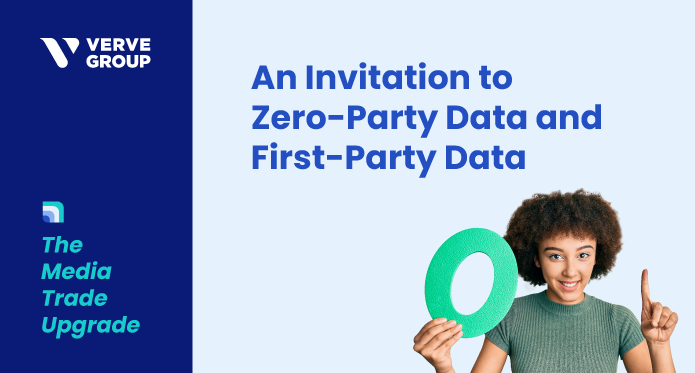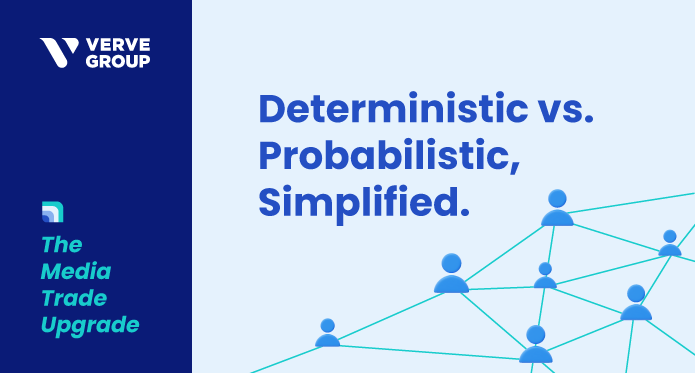‘Tis the season: Curated deals for year-end campaigns

As the weather cools in Q4, pressure heats up for programmatic media traders to run flawless campaigns, beat KPI targets, manage strict budgets, and handle high-pressure QBRs. Consider this blog our gift to you: a survival guide to year-end programmatic media trading.
The Media Trade Upgrade: Supply chain transparency for programmatic traders

This blog covers everything programmatic media traders need to know about transparency in the advertising supply chain in 2023. We’ll do a (very brief) refresher on the definition of the programmatic supply chain and why it matters to advertising overall. We’ll then spell out exactly what programmatic media traders need to know about how transparency impacts day-to-day media buying and optimizing campaigns.
The Media Trade Upgrade: An invitation to zero-party data and first-party data

Welcome to the third edition of The Media Trade Upgrade, where programmatic traders can get essential info to stay ahead in ad tech – all in quick, bite-sized pieces. Consider today’s blog post your invitation to an exciting party . . . of zero-party and first-party data. We’ll quickly recap differences of the different types of data, all the way from the definition of zero-party to third-party data. (Don’t worry – there’s no such thing as fourth-party data . . . yet!) Then, we’ll dig into how programmatic media traders can use zero-party data alongside first-party data for media planning that crushes campaign goals. Countdown: From third-party to zero-party Triple Threat: Third-party data Third-party data describes how an entity without a direct relationship with the end-user collects that user’s data. Aggregators can obtain data from multiple sources to offer a broad view of users when combined with third-party inputs. This data can be stitched together across various inputs to help create a broader picture of a user. Third-party data works alongside first-party data to improve targeting lists. Determining if third-party data was legally collected is challenging with changing privacy regulations and user data control. Bridging the Gap: Second-party data Second-party data occurs when one entity shares data about its users with a trusted partner. The data quality and accuracy is high, since it was originally one company’s first-party data. Second-party data is also available for purchase on certain data marketplaces. Publishers may also sell information to marketers, such as an ecommerce platform selling purchase history or customer loyalty data to an advertiser. The Gold Standard: First-party data First-party data is information collected from a company’s customers or audience, such as profile information, website purchases, or loyalty programs. This type of data is given freely and verified for accuracy, making it highly valuable. Take a user who creates an account to access free content on a news site. Any personal information they provide directly to the publisher, such as their email, gender, or birth date, counts as first-party data. Similarly, purchase history is another key example of first-party data. Fast fact: 78% of businesses consider first-party data as the most valuable source of data for delivering personalization to audiences. The Unsung Hero: Zero-party data Zero-party data refers to information that users proactively and willingly share with brands and advertisers, typically through direct engagement such as surveys, polls, or preference centers. Unlike first-party data, which is collected through user interactions with a brand’s website or app, zero-party data is explicitly provided by the user, giving them even more control over their personal information. Benefits of zero-party data in advertising and media planning The impact of zero-party data on campaign planning is significant for several reasons: Better user experience Zero-party data often includes valuable insights into a user’s preferences, needs, and interests. This information allows advertisers to create more targeted and personalized campaigns, leading to increased engagement and conversion rates. In 2022, 62% of consumers said a brand would lose their loyalty if the brand delivers an un-personalized user experience, up nearly 20% from 2021. Enhanced trust and transparency By collecting zero-party data, brands can demonstrate their commitment to privacy and transparency. For example, a hair-care brand might use a quiz to create a custom shampoo formula tailored to the user. The quiz should be very explicit in communicating that the user’s input (a.k.a., zero-party data) will only be used to provide personalized product, content, or marketing experiences. This kind of transparency can help build trust between the brand and its audience, fostering long-term relationships and customer loyalty. Compliance with privacy regulations With the increasing focus on data privacy and the introduction of stricter regulations like GDPR and CCPA, using zero-party data can help agencies and brands ensure compliance. Since users willingly share zero-party information, there is less risk of violating privacy laws compared to relying on second- or third-party data sources. Reduced reliance on third-party data As browsers phase out third-party cookies and privacy concerns grow, advertisers need alternative data sources for targeting and personalization. Zero-party data offers a more reliable and sustainable solution, allowing brands to maintain effective marketing strategies despite changes. To incorporate zero-party data into campaign planning, media buyers at agencies should collaborate with their clients to create engaging experiences that encourage users to share their information. This may include interactive quizzes, polls, or preference centers that capture user insights while providing value in return, such as personalized recommendations or exclusive offers. By collecting zero-party data that can power future campaigns, advertisers can drive better results while respecting user privacy and fostering trust. Considerations Before RSVPing to the Zero-Party Parting Thoughts Data, privacy, and identity are top priorities in ad tech. Explore more in our in-depth eBook, Identity: Decoded, which unpacks the intricacies of identity for marketers, consumers, and the supply side of advertising. Follow along on LinkedIn, or subscribe to our newsletter below!
The Media Trade Upgrade: Probabilistic vs. deterministic, simplified

Welcome to the second edition of The Media Trade Upgrade, the series giving programmatic traders essential info about the latest and greatest in ad tech – all in quick, bite-sized pieces. In today’s blog post, we’ll define the differences between deterministic vs. probabilistic data, what it means for audiences, and how it impacts campaign planning for programmatic traders. Ad tech has a reputation for jargon, but (for once) we didn’t make up these two: probabilistic and deterministic data have applications in many industries, academia, and other institutions. Don’t worry – we’re just talking about advertising today. Trending: Probabilistic and deterministic Using probabilistic and deterministic data to target audiences is nothing new. But, with third-party cookies becoming an endangered species, marketers need to make choices about alternative identifiers and identity solutions. By the end of 2022, 100+ identity solutions were available, according to Prohaska Consulting’s most recent Identity Partner List. What does this mean for advertisers? (Source: ID5 – The State of Digital Identity 2022) Programmatic traders increasingly need to participate in identity-related conversations. Understanding the nuances of probabilistic and deterministic audiences is key to these discussions. And now that the industry is tasked with finding alternatives to third-party cookies, the words probabilistic and deterministic are even more prevalent in team meetings and client conversations. Read on to stay in the know on this essential vocab. Deterministic audiences Definition: Deterministic audiences are groups created by data supplied directly from users. Deterministic data is also known as validated or qualified data. What it really means: These data points are usually accurate at the time of collection because they’re personally identifiable. Deterministic audiences are created from a snapshot of data, so accuracy may fade over time. Examples of deterministic data: Deterministic data may include gender, location, age, and other personal details. For example, users tracking exercise activity in a fitness app, might give the app publisher deterministic data like how often they run, bike, or do yoga. Depending on the user’s data privacy preferences and app permissions, the app publisher could use this information to create a data-confirmed cohort. Email addresses could also be used for a deterministic ID match. Is deterministic data the same as first-party data? It depends. Deterministic data like an email address supplied by a user falls under the umbrella of first-party data. Some data that isn’t user-supplied, such as transaction history, is still first-party (even though it’s not technically deterministic). Implications for campaign planning: Deterministic audiences make targeting (and retargeting) more accurate and effective and can be a more efficient ad spend. However, with limited first-party data, deterministic audiences aren’t as scalable and have campaign reach limitations. Probabilistic audiences Definition: Probabilistic audiences are groups with a high probability of being accurately profiled. These audiences rely on models built on a subset of deterministic data to identify a larger target audience. May be categorized at the individual or cohort level. What it really means: These audiences are based on probabilities — but can also be validated against deterministic data. Probabilistic audiences may be an alternative to purely deterministic ones, but they can’t exist without deterministic data. Examples of probabilistic data: Some probabilistic solutions also recreate identity using implicit signals such as IP address or a device user agent. While probabilistic audiences don’t have the surefire accuracy of audiences built with deterministic data, they are far more scalable. Let’s say a user is streaming video content on an Xbox. We don’t have a personal identifier and have no way of knowing who owns the console. Still, we can use these data points to categorize the user into a probabilistic audience and match them to relevant advertising content. In this example, we can infer that the user is probably a gamer. The fact that they’re streaming at 2 a.m. means there’s a good chance they’ll fit in our college-aged audience interested in late-night food delivery services. Implications for campaign planning: Audiences built with probabilistic data are at the heart of contextual targeting. Call us biased, but here’s a great example: Contextual solutions like Visual Intent use machine learning to target audiences based on how likely they are to consume content about certain topics. For advertisers, this creates an opportunity to place their ads alongside premium visual content, thanks to Getty Images’ exclusive partnership with Verve. The scalability of probabilistic audiences makes them ideal for awareness campaigns, but technologies like Moments.AI have already proven applications for more targeted conversion-oriented campaigns as well. According to ID5’s 2022 State of Digital Identity Report, 81% of DSPs and 79% of SSPs have already implemented one or more identity solutions. As a marketer, make sure you understand what your preferred DSP and other technologies use or integrate with. Pros and cons of deterministic vs. probabilistic data Which type of audiences should marketers use? Realistically, you’ll use both. Here are some of the benefits and drawbacks of probabilistic vs. deterministic audiences: Deterministic audiences Probabilistic audiences Pros High accuracy = improved targeting Predictive target can mean reaching audiences earlier in the buyer journey Cons Risk of using outdated data Privacy concerns Only as good as the deterministic data used to build the model TL;DR: Talking points about identity in ad tech More to the identity story Terms like probabilistic and deterministic are the tip of the iceberg when understanding the identity landscape. Verve is committed to providing clear, helpful content to support our friends and colleagues across ad tech, even if you’re not our customer. We have a recent in-depth eBook, Identity: Decoded, and plenty of blog and social content to help demystify identity for marketers, consumers, and the supply side of advertising. Follow along on LinkedIn, or subscribe to our newsletter below!
